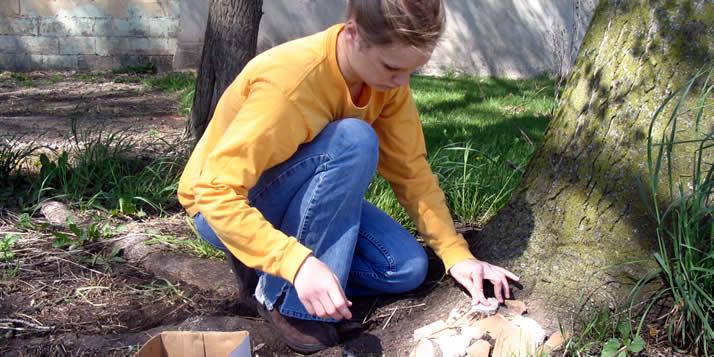PLANT! Sculpture, Gardens and Place

A class project is coined PLANT! and the effort expands the concept of sculpture into the creation of community gardens.
Every year, Calvin College art professor Adam Wolpa allows his sculpture class to choose their final project, which they accomplish in teams.
This year, the class project is coined PLANT! and the effort expands the concept of sculpture into the creation of community gardens.
As they fashion their neighborhood gardens, the students, Wolpa says, are also exploring the concept of “place.”
“We’re kind of breaking out of the traditional definitions of sculpture and art,” Wolpa says of the garden-as-sculpture project, “but there are definitely concerns involved that are similar to artistic concerns. You’re talking about color, texture, lines. And when you’re landscaping, you’re shaping the earth.”
Wolpa’s students are shaping the earth at six different garden sites in Grand Rapids: in the Baxter, Eastown, East Hills, Fulton Heights, Alger Heights and Heartside neighborhoods.
Both the sites and the student teams who tend them were chosen based on where the students live.
Each team is sculpting their garden in a different way.
The team assigned to Baxter is designing a traditional English garden, while the group cultivating the Fulton Heights plot is growing herbs. The team looking after the Heartside plot is doing a garden deconstruction; they are “walking lines” that symbolize traditional garden rows.
While shaping the earth, says Wolpa, the students are also shaping the idea of what sculpture is.
"Part of the project," he says, "is to explore some of those questions like, ‘Is it art?’ ‘Is it sculpture?’ ‘What’s the sculpture part?’”
PLANT! also stretches the traditional boundaries of art as students examine their sites’ geography, topography, history, community, science, botany and other features.
PLANT! even stretches the boundaries of the classroom, Wolpa adds, because the gardens function as artistic studios as well as art works.
“We’re taking the art classroom and putting it in a specific place, a neighborhood that has a history and neighbors,” he says.
Indeed the concept of “place” is central to PLANT!.
The student gardens are a study of how a specific city or region influences a work of art and how that work of art in turn affects the place it was made.
“One of the requirements of the project is that you use materials from the neighborhood, and so you’re using appropriate technology,” Wolpa says. “Another requirement is that the students form relationships with the people in the neighborhood.”
Each team is documenting their gardening insights and experiences, including the interactions they have with neighbors, on the PLANT! website at www.plant.g-rad.org
PLANT! was inspired by another Calvin project, a study called “Strengthening Liberal Arts Education by Embracing Place and Particularity,” funded by $100,000 grant from the Teagle Foundation.
Wolpa is one of several members of the Teagle study group, which examines how a liberal arts college like Calvin and the community in which it is located shape each other.
“We’re involving faculty across disciplines in this project,” says Gail Heffner the Calvin director of community engagement who supervises the Teagle effort.
Heffner is excited about Wolpa’s class project.
“This is kind of creative new direction," she says. "I would have thought about sociology students getting invested in neighborhoods or nursing students getting invested in neighborhoods or political science students getting invested in neighborhood. But I hadn’t thought about art students getting involved in neighborhoods.”
Wolpa, who gardens along with students at the Fulton Heights site, is enjoying not only the relationships his students are forming with place, but also the relationships they are forming with each other.
“Instead of meeting our classes in the basement, we’re meeting our classes at our sites," he says. "Our group is meeting at our house and starting with breakfast. It’s just kind of refreshing to just be outside and enjoy the company of my students in that personal way.”






